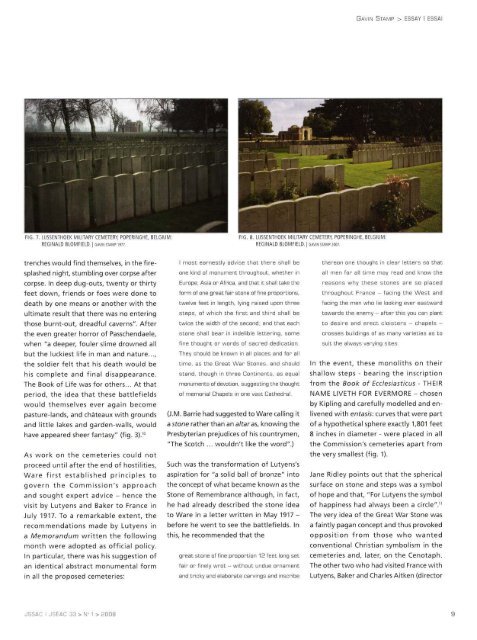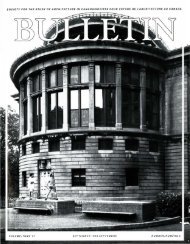CANADA - SEXTONdigital
CANADA - SEXTONdigital
CANADA - SEXTONdigital
You also want an ePaper? Increase the reach of your titles
YUMPU automatically turns print PDFs into web optimized ePapers that Google loves.
GAVI N STAMP > ESSAY I ESSAI<br />
FIG. 7. LI JSSENTHOEK MILITARY CEMETERY, POPER ING HE, BELG IUM:<br />
REGINALD BLOM FIELD.I GAVI N STAMP 1977.<br />
FIG. 8. LIJSS ENTHO EK MILITARY CEMETERY, POPERINGHE, BE LG IUM<br />
REGINA LD BLOMFIELD. I GAVIN STAMP 2007.<br />
trenches would find themselves, in the firesplashed<br />
night, stumbling over corpse after<br />
corpse. In deep dug-outs, twenty or thirty<br />
feet down, friends or foes were done to<br />
death by one means or another with the<br />
ultimate result that there was no entering<br />
those burnt-out, dreadful caverns". After<br />
the even greater horror of Passchendaele,<br />
when "a deeper, fouler slime drowned all<br />
but the luckiest life in man and nature ...,<br />
the soldier felt that his death would be<br />
his complete and final disappearance.<br />
The Book of Life was for others ... At that<br />
period, the idea that these battlefields<br />
would themselves ever again become<br />
pasture-lands, and chateaux with grounds<br />
and little lakes and garden-walls, would<br />
have appeared sheer fantasy" (fig. 3). 10<br />
As w ork on the cemeteries could not<br />
proceed until after the end of hostilities,<br />
Ware first established principles to<br />
govern the Commission's approach<br />
and sought expert advice- hence the<br />
visit by Lutyens and Baker to France in<br />
July 1917. To a remarkable extent, the<br />
recommendations made by Lutyens in<br />
a Memorandum written the following<br />
month were adopted as official policy.<br />
In particular, there was his suggestion of<br />
an identical abstract monumental form<br />
in all the proposed cemeteries:<br />
I most earnestly advise that there shall be thereon one thought in clear letters so that<br />
one kind of monument throughout, whether in all men for all time may read and know t he<br />
Europe, Asia or Africa, and that it shall take the reasons why these stones are so placed<br />
form of one gr eat fai r stone of fine proportions, throughout France - facing the W est and<br />
twelve feet in length, lying raised upon t hree facing the men who lie looking evel' eastward<br />
steps, of which the first and t hird shal l be towards the enemy - after this you can plant<br />
twice the width of t he second ; and that each to desire and erect cloistei'S - chapels -<br />
stone sha ll bear in in deli ble lettel'ing, some crosses buildings of as many va r ieties as to<br />
fine thoug ht or words of sacred dedi cation. suit t he always val'ying sites.<br />
They should be known in all places and fo r all<br />
time, as the Great War Stones. and should In the event, these monoliths on their<br />
stand , though in three Continents. as equal shallow steps- bearing the inscription<br />
monuments of devotion , suggesting the thought from the Book of Ecclesiasticus - TH El R<br />
of memorial Chapels in one vast Ca t hedr al. NAME LIVETH FOR EVERMORE -chosen<br />
by Kipling and carefully modelled and enlivened<br />
(J.M. Barrie had suggested to Ware calling it<br />
a stone rather than an altar as, knowing the<br />
Presbyterian prejudices of his countrymen,<br />
"The Scotch ... wouldn't like the word".)<br />
with entasis: curves that were part<br />
of a hypothetical sphere exactly 1,801 feet<br />
8 inches in diameter- were placed in all<br />
the Commission's cemeteries apart from<br />
the very smallest (fig. 1).<br />
Such was the transformation of Lutyens's<br />
aspiration for "a solid ball of bronze" into<br />
the concept of what became know n as the<br />
Stone of Remembrance although, in fact,<br />
he had already described the stone idea<br />
to Ware in a letter written in May 1917-<br />
before he went to see the battlefields. In<br />
this, he recommended that the<br />
Jane Ridley points out that the spherical<br />
surface on stone and steps was a symbol<br />
of hope and that, "For Lutyens the symbol<br />
of happiness had always been a circle". 11<br />
The very idea of the Great War Stone was<br />
a faintly pagan concept and thus provoked<br />
opposition from those who wanted<br />
conventional Christian symbolism in the<br />
great stone of fine proportion 12 feet long set<br />
fail' or finely wrot - without undue Ol'nament<br />
and tricky and elabm'ate carvings and inscribe<br />
cemeteries and, later, on the Cenotaph.<br />
The other t w o w ho had visited France with<br />
Lutyens, Baker and Charles Aitken (director<br />
JSSAC I JSEAC 33 > N' 1 > 2008<br />
9
















